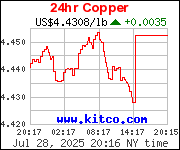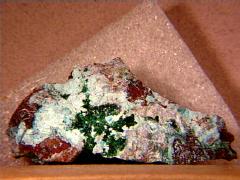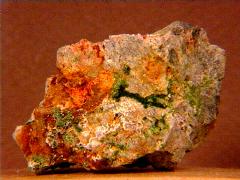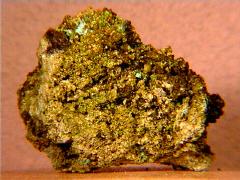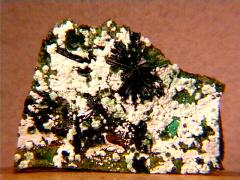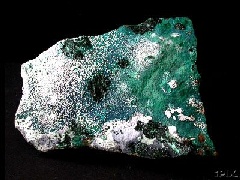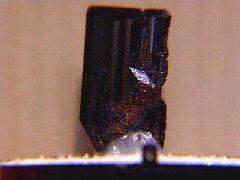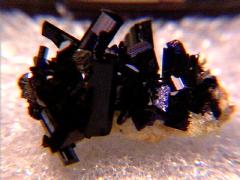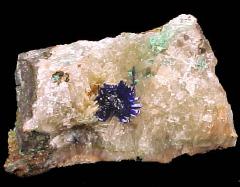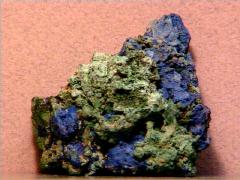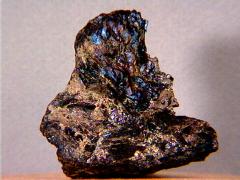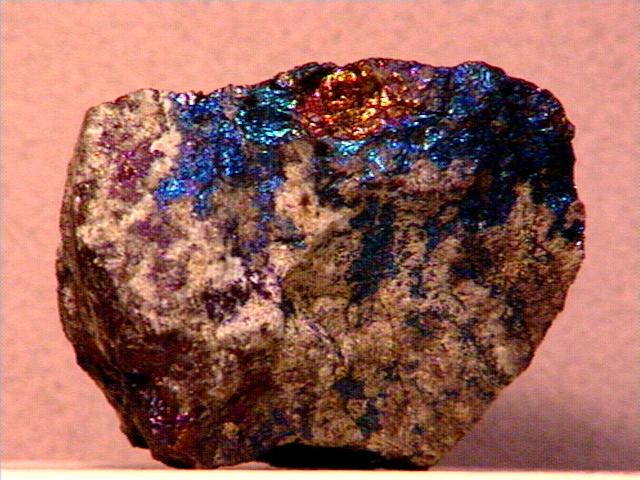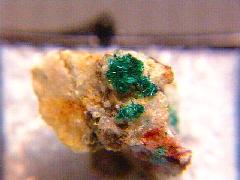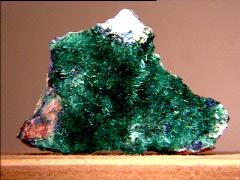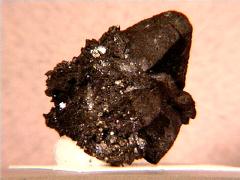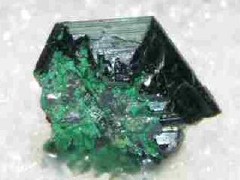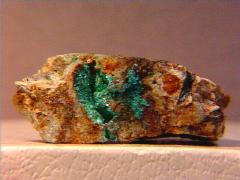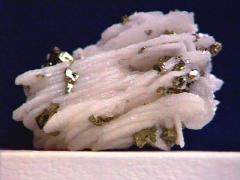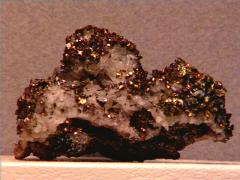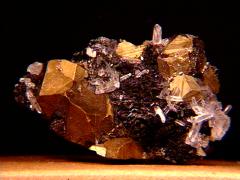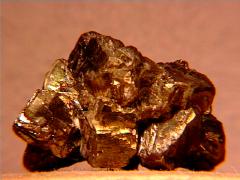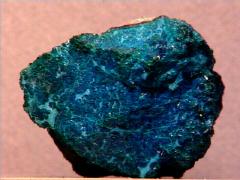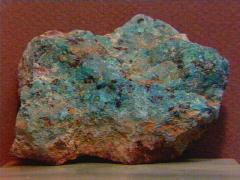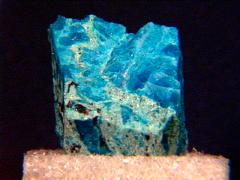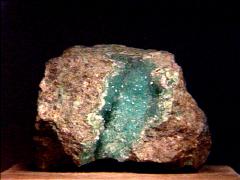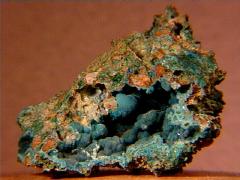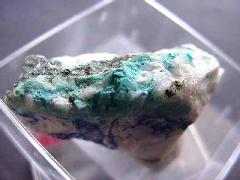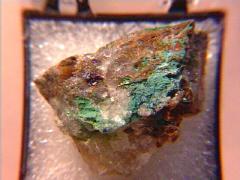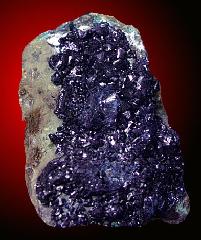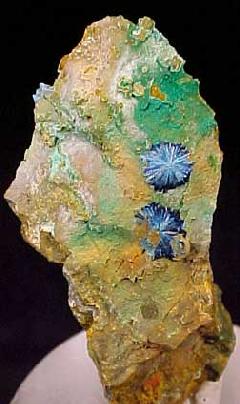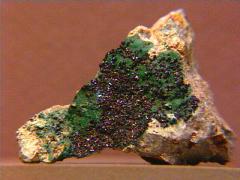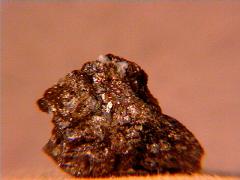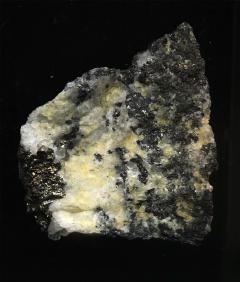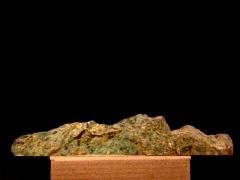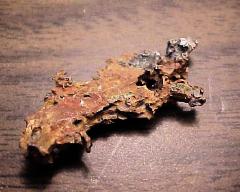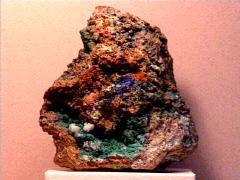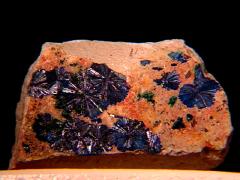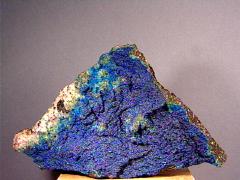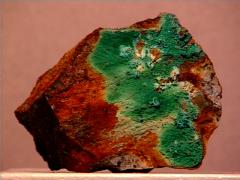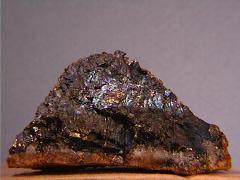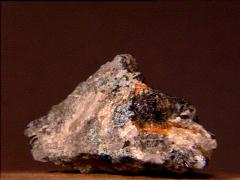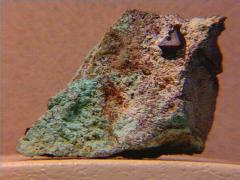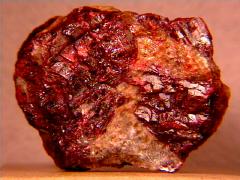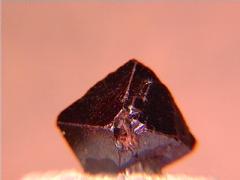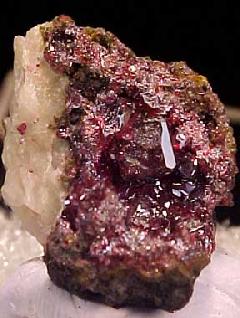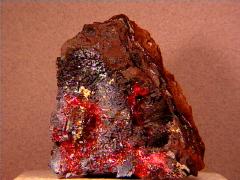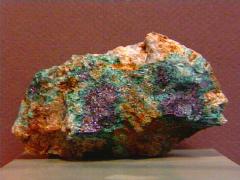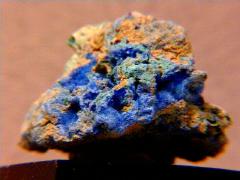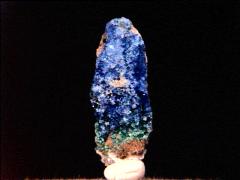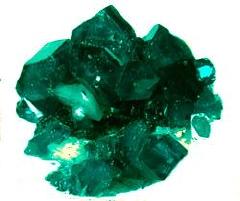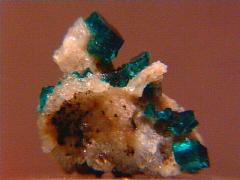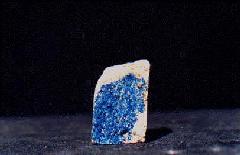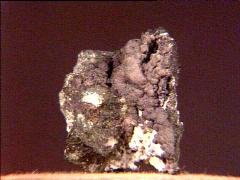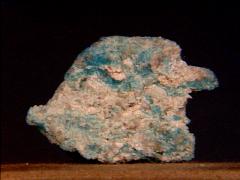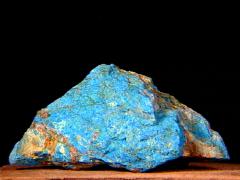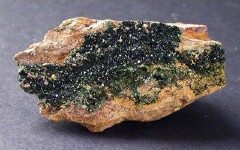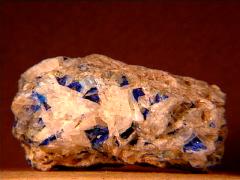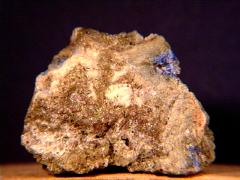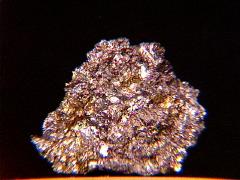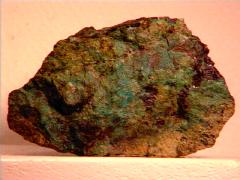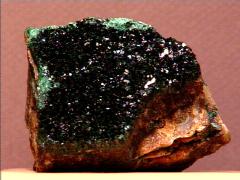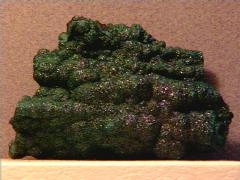Thursday, December 31, 2009
Long Term Gain or Short Term Profit?
Christmas brought an opportunity, like merchandisers following the Holidays, to pick up some gifts at bargain prices. This may be because trading in metals commodities is traditionally lighter during this period. Whatever the cause, silver and gold have temporarily drifted downwards in price. Gold under $1100 and silver under $17.00 offer attractive entry points. Buy yourself a gift, before the shelves are stripped of overstock. Obtain some real money - silver and gold - that you physically hold. You don't have to buy the copper; you can save it from your change.
Most Americans - even if they don't understand Gresham's Law - that bad money drives good money out of circulation, had a chance to see that in action in 1965. Prior to that year, dimes, quarters, and half dollars were fabricated from a silver/copper alloy that was 90% silver. When, in 1965, the United States Mint began using a cupronickel "clad" alloy to make dimes and quarters, and reduced the silver content in halves to 40%, people inherently understood that the older coins made from noble metal had a greater worth than their base metal counterparts.
They began to pull those older silver coins out of circulation. In fact this action created such a vacuum of circulating coinage as people began to hoard the silver, that the Mint was forced to address the sudden shortage by vastly increasing their normal production of coins. In each of the three years subsequent to the changeover, the Mint exceeded the amount of dimes previously produced as late as 1963 by about a factor of three. In quarters, the amount produced in 1963 was less than twenty percent, on average, of what followed in 1965, 1966, and 1967.
People instinctively understood that the silver coins had an intrinsic value attributed to their precious metal content, that was in excess of their nominal value. That's why they pulled them from circulation and began to hoard them. This all started forty-five years ago, and now those same coins will fetch twelve to thirteen times face value. Their worth, priced in constantly diminishing dollars, is guaranteed to rise as our currency goes down in flames like the Hindenburg. I've heard people state "I wish I could have been alive then, to pull that silver out for face value!"
Well, Siegried, you've got that opportunity now with copper. The value of a copper penny - as can be determined by a visit to coinflation.com - is worth in excess of twice it's nominal value. Can't you just picture James Cagney? Muttering, "ya dirty two-faced copper, I oughta fill ya full of lead." Pre-1982 copper cents were composed of 95% copper and 5% zinc, making them an ideal form of bullion to begin accumulating in anticipation of the dollar depreciation that will accompany the onset of hyperinflation. My magic eight ball says we might have about six months left before that happens.
I like to participate on a forum - realcent.forumco.com - where our group gathers to share ideas, swap questions, provide answers, and sometimes tell tall tales, to one another. We started out as a copper forum but have branched out to now include nickel, silver, and gold as well. Our members range from newcomers with just about any question imaginable to veterans like HoardCopperByTheTon, a site administrator with legendary near-deity status. Who needs Wikipedia when you can just ask Hoard? Recently, one member questioned whether it was worth it to sort anymore, since the sellers market for copper cents is presently limited.
At present, there is a secondary market of buyers willing to purchase sorted copper cents, but the market has receded from previous highs. Coinflation shows the present value of the copper in a pre-1982 penny to be worth 2.196 cents apiece. Copper cents are commonly traded "in bulk" at levels of $100 face value. A very well reinforced carton to ship this amount will weigh in between 68 to 70 pounds, and is the limit the post office will accept. So wouldn't you think that you could sell that face amount for $220 plus shipping? Sadly, this isn't currently the case.
Currently is the salient word. The market for copper cents is presently under-developed. Those individuals willing to purchase today - at what seem to be lowball bid prices - are assuming the risk that the present melt ban may not be removed at any time soon in the future. Accordingly, while the current melt price of copper hovers rangebound, the prices offered for $100 face value of pure pre-1982 copper cents is currently near $150. Shipping cost is assumed by the seller, or accepted by the buyer, subject to negotiation. $100 face lots did sell for $225 on ebay in the past, those prices will resume eventually.
There is an additional reason that some buyers may be reluctant to purchase sorted cents, or to increase their bid above this going rate. There is not yet any scarcity of these copper cents in circulation. If you have the time, a little bit of cash, and the interest in doing so, you can sort and save these pennies yourself. Over 100% instant return, with no downside risk. Where else can you get that promise? Those who read these columns understand that copper is headed up, and these cents - like the pre-1965 90% silver coins - will someday disappear from circulation.
That is when the prices paid for individual pennies (sold in bulk) will jump. Either as a factor of scarcity due to Gresham's Law, or because the price of copper as a commodity increases, or because the melt ban is lifted, or because hyperinflation causes the utility of barter with coins to increase in attraction, the price will increase. You can already see the scarcity issue in play now, as pre-1959 Lincoln cents - called wheaties - fetch a price of four times face value on ebay when sold in bulk. Individual numismatically desirable pennies draw bids of several dollars.
The question raised on realcent seemed to focus on the potential for short-term profit, not on long-term appreciation. Holding copper for eventual gain is a good investment, but what this member was asking was "is it a good way to make money?" Sorting copper by hand is time-consuming and labor intensive. It can result in eye strain. There are costs incurred driving to the bank, both to get your unsorted pennies, then later to redeem your zincs (post-1982 pennies). If this isn't a hobby that you love, should you be involved merely for mercenary reasons?
The answer might be maybe not. Not at this point in time, anyway. Right now, selling the fruits of your labor for pennies on the dollar may be more trouble than its worth. For that's what you're doing actually. You're selling your time and effort and expenses expended to sort the copper and produce the final lot, not so much selling the copper itself. A few buyers are willing to pay the going rate to save themselves the effort and associated costs of sorting themselves, but a precarious balance is at play here. Charge too much, and they will go back to doing it for themselves.
Can you make money sorting and selling pennies at current prices? Yes, but it is not an easy road to riches. It is a slow process that allows you to gradually increase your capital. One hundred dollars invested becomes $150. Add in some time and $150 becomes $225. Devote some effort and $225 becomes $337. $337 becomes $506. One more sale and $506 grows to $759. $759 becomes $1139. An individual recognizing the merits of copper investment, but with limited resources, would still have only the initial $100 saved in copper cents.
But look what the entrepreneur with the "can-I-make-money-now?" outlook has accomplished. It may be a slow arduous process, but sorting and selling the initial hundred dollars has grown it to the point that could permit purchase of a penny-sorting machine to simplify and accelerate the entire assembly line process. Is selling pennies quick easy profit? No, but many realcent forum members can attest to having accrued large hoards of copper cents and labor-saving equipment from this same humble beginning. Confucius say "the longest journey starts with but the first step." Follow the copper brick road.
Buy Silver. Buy Gold. Save Copper. Start Now.
Friday, December 25, 2009
A Crowning Achievement
The Kentucky Derby is 1 1/4 miles in distance. It's held at Churchill Downs, in Lexington, Kentucky. It's the first of the Triple Crown races, held from May through early June. It's followed by the Preakness Stakes, a race of 1 3/16 miles, held at Pimlico Race Course in Baltimore, Maryland. The final gem in the crown is the Belmont Stakes, 1 1/2 miles in length, held at Belmont Park in Elmont, New York. A horse that wins all three races in one year has mounted the utmost pinnacle of thoroughbred horse racing in the United States, and is considered a Champion without rival.
Winning the Triple Crown is such a rare achievement that it has been accomplished only eleven times in history, and not since 1978. Only the most indefatigable steed - fleet without equal - can hope to cross the finish line first in all three races. And only a premier jockey would mount such a beast, presuming to be a contender for the crown. It requires the commingling of the strength of the horse and the skill of the rider to vanquish their foes. To succeed, they must develop a symbiosis, virtually becoming almost as one, as if through some marvelous transmogrification they had transformed into a centaur.
If a razor-thin, rodent-faced, grotesque gnarled gnome of apparent Middle Eastern heritage - cheeks pockmarked with more acne scars than the moon has craters, smoking a stogie and belching more fumes than a Chinese coal factory smokestack - had walked up to you in 1973 and snapped you on the forehead with a rolled up Daily Racing Form and then leaned in to confide sotto voce "Fast Eddie is bettin' on Secretariat to win the Derby," would you have listened? What if he was dressed like Aladdin's djinni of Arabian Nights fame?
What if he was wearing a bejeweled carmine turban, embroidered gold lame vest, billowy silk parachute pants, and pointy-toed slippers with curling tips? And he informed you in his seemingly incongruous nasal Jersey accent "someone rubbed me the wrong way this morning," as he glanced around furtively,"and youse is the first guy I saw, so's I gotta grant ya tree wishes. See, I'm a Genie." If you saw him again in 1977 and he told you, "Seattle Slew, bet it all," and followed this advice with "Affirmed, I ain't gonna tell ya agin," in 1978, would you pay attention?
If you knew - before the race had begun - which horse was going to win, would that influence your wager? You wouldn't need to rely on instinct - to place what would turn out to be a losing bet - for Alydar to win at Churchill Downs in 1978. Let's depart from these musings for a moment to indulge in metaphor. The race for the finish line could be likened to the various elements of metals commodities all vying for the greastest percentage gains. Which horse will win? Will it be Barbarous Relic? One Shining Moment? Or Big Red? Gold, silver, or copper?
Is it even fair to include copper in the conversation if you're talking about bullion? After all, it's not a precious metal. Isn't it a base metal? Its main uses are industrial, not a store of wealth. Why would you expect it to increase in value under the effect of the same stimuli that are giving impetus to price appreciation in silver and gold? Will the same leather crop applied to the flank work to spur different horses? What is causing them to run at their present speed, and which might win the race? All will do well, but in which order might they win, place, or show?
The fiscal policies of our government, aided by the loose monetary practices of the FED, have resulted in the creation of a massive amount of new money. As a consequence of TARP, but extending further than that futile attempt to rescue banks whose balance sheets were bloated with toxic subprime mortgages, the money supply doubled. This took place in a little more than four months. Price inflation generally lags money creation by eighteen to twenty-four months, but commodities - goaded by this catalyst - are sure to soar.
It's no different than if a contingent of Emirate sheiks crowded to the front of the pari-mutuel betting queue to place colossal wagers on their favorite Arabians. The effect of such a sudden injection of funds of this magnitude - expanding a circumscribed reservoir of money - would cause an incalculable impact. At the time of the influx, we would be unable to ascertain what ripple effects would eventually result. The recently infused wave of liquidity is sure to have ramifications we can't yet comprehend. Let me offer an idea of what those repercussions might be like.
You're going to witness an exponential increase in the price of everything. Prices for food, gasoline, medical expenses, insurance, and utilities are going to quickly become unaffordable; particularly injurious to those on fixed income. You're going to have to purchase precious or base metals commodities to preserve your purchasing power. If you can determine which commodity has the best odds of increasing in price as the inflationary tsunami approaches land, you stand to not only survive, but to thrive. Investors who - in recognition of this likelihood - took early action, have contributed to the unheralded precious metals bull market that began in 2002.
Silver and gold have both demonstrated laudable gains affording greater profits than like investments in stocks or bonds would have realized during the same time frame. They've both emerged to recent acclaim; one can no longer characterize their advance as stealthy. Gold captures the spotlight; it wasn't that long ago that the evening news was replete with new highs that it approached or breached. Often for several days in a row. Silver lags, but has the potential to surpass Gold's percentage increase by multiples. Yet, there have been periods when both of these "safe haven" metals were outperformed by copper.
"Sure," you'll say, "any given commodity might outperform others at any particular time." This is true, and the following example is illustrative. Within any given window of reference, performance is dependent on a number of variables. Copper underwent a deeper retrenchment than silver or gold, thus just getting back to par with its levels of early 2008 makes it seem all the more impressive. If you wait to buy on these deep pullbacks - that aren't justified by fundamentals - each metal will give you frequent entry points that can prove profitable. But you'll have to overcome your reluctance to "try and catch the falling knife."
Copper is like an unappreciated maiden attempting to compete with known winners. After the global scare of October 2008, metals commodities were reigned in hard, some halted in their tracks. Although they rebounded as a recovery of sorts took place, they took another hard stumble in the mud in February 2009. Since their lows of that month, Big Red has been breezing in morning workouts and racing handily. One Shining Moment and Barbarous Relic are still on lead from their grooms, circling in their paddock, slowly warming up to overcome stiffness.
There is such volatility in the precious metals market, it's almost like weighing kiwis and cantaloupes to attempt to compare copper with silver and gold. Yet from that low of February 9, 2009 gold has climbed from approximately $888 an ounce to $1104, for a gain of 24.3%. Silver has progressed from $13.00 to $17.50 an ounce for an advance of 34.6%. Copper outperformed both, climbing from about $1.40 to $3.21 a pound. That was an incredible 129% leap, reminiscent of Secretariat's 31 length going away win at the Belmont in '73. Sometimes it doesn't matter where you are in the pack, but rather how swiftly your horse is pacing at the moment.
Finally, a strategem that is sometimes given short shrift is relative volatility. Pay heed to Ted Butler and you'll awaken to the fact that there's massive naked short selling in silver futures on COMEX, by Goldman Sachs and JPMorgan. Bill Murphy of GATA, along with John Embry of Sprott Asset Management Group claim to have incontrovertible evidence demonstrating their allegation that gold prices systematically suffer severe suppression. They claim that various Central Banks, colluding with our own vaunted Plunge Protection Team, periodically conspire to smother the gold market by a combination of pervasive gold leasing compounded by profuse short selling.
Copper's primary utilization is by industry. It doesn't wield the significant repute of a monetary fortress with long-acknowledged prowess for defending purchasing power. Most analysts fail to consider it a harbinger of inflation if its price rises moderately, thus its increase in value is not viewed as a bellweather of dire depreciating dollar dysfunction. Base copper seemingly escapes the machinations that its noble cousins suffer, and therefore manifests a relatively stable mood. Gold and silver are like bipolar patients in One Flew Over the Cuckoo's Nest, who refuse to take the lithium dispensed by Nurse Ratched. Roaming the halls, free of pharmacological restraints, they are subject to either glee or despair, correlating to their highs and lows.
The point of this piece, then, is you don't really need to scurry around the grandstands trying to handicap the horses, attempting to predict which may prove the favorite. You aren't gambling - endeavoring to win the Trifecta - by picking the exact order of the top three finishers in correct sequence. They're all winners; proven Champions. It doesn't matter if one steed is galloping, while another is cantering or trotting. A third may even be motionless, temporarily hobbled by a painful hoof spur. It doesn't make any difference. Bet the whole program; all three will do well. Call it real money physical metals asset allocation. It's a bet you're sure to win.
Buy Silver. Buy Gold. Save Copper. Start Now.
Pennies From Heaven
Remember the game show To Tell The Truth? Hosted by Bud Collyer, it premiered in 1956 and ran through 1968, with various personnel changes along the way. The cast that I remember had panelists Tom Poston, Peggy Cass, Orson Bean, and Kitty Carlisle. They would question a contestant, all claiming to be the same character. At the end of the show, after their conclusions had been reached, the moderator would ask "Would the real Mr. Mystery please stand up?"
So, would the real Pennies from Heaven please stand up? Contestant Number One? Is it an American song popularized by Johnny Burke and Arthur Johnston? The lyrics of which were:
"Ev'ry time it rains, it rains pennies from heaven
Don'tcha know each cloud contains pennies from heaven?
You'll find your fortune fallin' all over town
Be sure that your umbrella is upside down
Trade them for a package of sunshine and flowers
If you want the things you love, you must have showers
So when you hear it thunder, don't run under a tree
There'll be pennies from heaven for you and me
Those lyrics were a hit in their time, and crooners like Billie Holliday, Bing Crosby, Frank Sinatra, as well as Louis Prima and his Dixieland Band all stepped up to the microphone to perform their own rendition.
Contestant Number Two? Pennies from Heaven was a 1936 film, introducing the song, which subsequently was nominated for an Academy Award for Best Song and Best Lyrics. Starring Bing Crosby and Madge Evans, this Depression Era story portrays the falsely accused Crosby as Larry Poole, a self-confessed "troubadour", who crosses paths in prison with a deathrow inmate. The prisoner, seeking redemption, wants to leave some property to the relatives of his victim. Larry promises to do what he can to assist. He seeks to help out by delivering the deed, but as is often the course, his plans go awry.
Contestant Number Three? Pennies from Heaven was a 1978 BBC television series, written by Dennis Potter, and starring Bob Hoskins in a role which gained him notoriety and propelled his career on a fast track in the United Kingdom. Wikipedia states Pennies won the British Academy Television Award for Most Original Programme. In a 2000 poll of industry professionals conducted by the British Film Institute to find the 100 Greatest British Television Programmes of the 20th century, Pennies from Heaven was placed at number 21.
Contestant Number Four? Pennies from Heaven was a 1981 musical, adapted from the 1978 British Broadcasting Company television series of the same title. The movie starred Steve Martin in his first dramatic role, one for which he practiced tap-dancing for six months. Also starring were Bernadette Peters, and Christopher Walken. It's lavish dream sequences provided a stark contrast to the Depression Era 1934 Chicago setting in which it ostensibly took place. Dennis Potter was nominated for the 1981 Academy Award for Writing Adapted Screenplay.
Whatever the source of this curious phrase, I'd like to use it as a springboard to discuss a philosophical consideration of philanthropy, this being the Christmas Season. From the time we were little, when our parents wanted us to share our toys, I can remember mine telling me "it's better to give than to receive. Because of the economy, times are tough for everyone. Charities around the country - from Toys for Tots, to The Salvation Army - are reporting a drop in donations.The SPCA reports more owners are unable to provide adequate care for their pets, and are subsequently relinquishing them to humane society centers in increasing numbers. Chemung County reports that in 2008 they experienced an almost fifty percent increase in owner-surrenders over 2007. The burgeoning population of cats and dogs - that are neither neutered nor spayed - is leading to a proliferation of litters of kittens and puppies abandoned in the outskirts of communities. These animals will starve if not rescued, and there are not enough responsible owners willing to adopt those that do find their way to animal shelters.
And animals aren't the only ones going hungry. One in eleven Americans are now on food stamps. A survey of 180 food banks, conducted in late April and early May of 2008, found that nearly one hundred percent have seen an increase in the number of clients served within the last year. The increase is estimated at 15 percent to 20 percent, though many food banks reported increases as high as 40 percent. http://www.fundmymutualfund.com/2008/05/food-banks-suffering-in-us-children.html
Food banks represent the food source of last resort for the indigent, needy, and homeless. But there is a growing demand as well from clients one would not normally associate as needing such assistance. "We're getting calls all the time from people who want to know how to get here," said Kristine Gibson, community outreach manager at the Stockton food pantry. "And when I ask where they live, they give an address of a nice neighborhood, one where you or I would want to live."
Unfortunately, the economic downturn is having a disastrous effect on everyone. Seventy percent of households are struggling to make ends meet, living paycheck to paycheck. Financial contributions, as well as durable goods and perishable food items are languishing as well. Demand is up, but supplies are down, if not nonexistent. "The way it's going, we're going to have a food disaster pretty soon," said Phyllis Legg, interim executive director of the Merced Food Bank, which serves 43 food pantries throughout foreclosure-ravaged Merced County.
So, we should be in agreement that a need exists. How does this reconcile with my usual columns on how to get started investing with a limited budget? Just this. I have been promoting the cause of protecting yourself against the imminent depreciation of the dollar. The pernicious practices of our administration, the profligate porkbarrel spending of Congress, and the poverty-inducing plunge in purchasing power promulgated by the FED's hyperinflationary quantitative easing policies have cast us adrift in financial rapids that are swift approaching a precipice.
You will need to purchase precious metals to survive the economic maelstrom for which we are irretrievably destined. Gold. Silver. Platinum. Perhaps even palladium. And for those of you who can't afford even the $20 if might cost to visit the coin shop and purchase an ounce of silver, check your change. If you have, literally, even just two cents to rub together, check their dates. One might be a pre-1982 Lincoln cent, which had 95% copper content. Saving those cents gives you an affordable means of participating in a base metals price rise that could offer monetary insurance similar to that provided by the "safe haven" precious metals.
After sorting through mounds of pennies found at home or obtained via your bank or credit union, one annoyance to copper cent collectors is what to do with the pesky post-1982 97.5% zinc pennies that you wish to discard. They build up quicker than you'd like to admit, almost as if they were pestiferous cockroaches - Periplaneta americana, insects of the order Blattaria - oblivious to Raid, haughtily accumulating where they fall on the floor, boasting that if there's ever nuclear holocaust that they'd survive while you would not. But I digress.
If you are fortunate enough to shepherd your resources to build a profit and work towards accumulating a fortune, rather than the goal being merely attainment of a degree of wealth for yourself that you might live in unimaginable luxury, why not begin to make charitable contributions? If it works for Warren Buffett and The Bill and Melinda Gates Foundation, why not emulate their philanthropy, albeit on a much smaller scale? The Bible encourages us to tithe ten percent of our income. You need not attend church to bestow lagniappes.
But say you do attend church to hear your favorite preacher - bearing an astonishing resemblance to Max von Sydow - deliver a Yuletide sermon in Swiss-accented English? As music plays the offering plate is passed. Say the feeble Bible-toting arthritic septuagenarian spinster prayer warrior sitting next to you has to accept the red velvet lined oak collection plate from you. The one that you had just heaped with thirty-five pounds of zinc pennies. Can you imagine the delight that might play across her face as she smiled and hissed "God Bless you, Moron!"
And as the ushers returned to the dais to deposit their booty, wouldn't it make your heart lift in triumph to know that you had been integral to swelling the church coffers and helping the needy in their Outreach Program? Pastor von Sydow lifts his eyes heavenward and pauses for a moment in spiritual piety, then intones "Ve haf much to be tankful for tonight. Ve haf pennies. I haf never seen so many pennies for Heaven's Sake." Tears would fill his eyes, so that one could never doubt his sincerity. "Zincs alot, My Brethren. Ve haf Pennies from Heaven."
Buy Silver. Buy Gold. Save Copper. Start Now. Get rich. Give some away.
Saturday, December 19, 2009
How To Become A Penny Pincher
What if your problem stems, not from "what do I invest in, to get the safest return?" Or, "where might I achieve the quickest and highest gains?" Instead, your dilemma is debt? Well then, Gardener, we have a different problem to contend with. Although I doubt you would be haunting the cyber halls of financial investing sites - reading advisory pieces, looking for tips - if you lacked sufficient capital and discretionary income to begin investing in the first place, I can't make that assumption.
If your problem is debt - at a level at which it is burdensome, or even crushing - you shouldn't be here at all. Financial advisors always caution that you should never invest money you can't afford to lose. If you have credit card debt, with banks that charge exorbitant interest rates, you need to pay them off before considering speculative market trading. If you're straining your budget so tightly that you're living pay check to pay check, you need to make sure you're putting food on the table.
If your job is in jeopardy, you should first attempt to minimize unnecessary debt. Not only do you need to live frugally to save money, you ought to start building an emergency fund capable of sustaining you for three to six months without income. The most important thing you can do is to remain solvent, to continue making monthly payments on your home. If you fall behind on your payments, your delinquency could result in a default on your mortgage, and you could face foreclosure.
I hope I've impressed upon you the necessity of taking care of the basics first. Pay off your credit cards. Many banks now routinely charge 18 percent interest, and that rate is for their better customers. Some charge as much as thirty percent. This is usury in my opinion, but I don't make the laws. Consumer protection groups have lobbied Coach Congress to enact legislation limiting the banks from arbitrarily changing the rules mid-game, but the umpires won't be on the field until February 2010.
Have you calculated how much you would actually have to earn in returns to exceed the rate of interest charged on your cards? Let's consider the lower figure of eighteen percent. You are in a tax bracket which only deducts 25% of your gross wages. Your net wages from a $1000 pay check would thus be $750. In order merely to equal the 18 percent you are paying from after tax net income, you would need to earn a 22.5% return, compounded monthly. Not very likely.
So, in the real world, it's not going to happen. Before you consider investing, pay off the credit cards. Eliminate those which charge the highest interest rates first. There are debt calculators: http://www.bankrate.com/calculators/credit-cards/credit-card-payoff-calculator.aspx which inform you how long it will take to pay off a particular balance. You can console yourself about "missing out" on the stock market rebound when you realize how much you're sparing yourself in outlay on monthly interest charges.
Yes, it's tempting to consider stock market speculation, especially if your friends boast about how much money they've made in a short period. But look how much you would have to earn. Are they making those kind of returns? Also, money invested in the stock market is not always liquid; you could get into the "next sure thing" asset class, yet have to sell at the worst possible time and absorb a loss rather than attain a profit. Past performance does not guarantee future results.
Returning to our gardening analogy, I'd like to offer guidance as to how to obtain that first seed money. How do you start investing without extra income? The text that follows will be old hat for haberdashery habitués, but hopefully, hand out handy hints to hatch helpful habits. Having hard cash is not happenstance, it must be held, hidden, and hoarded from take home pay. Since the main purpose of my columns is to encourage readers to consider small entry positions into commodities, it requires the spare income to do so.
There are sites on the Internet today that can instruct you on how to budget, how to live cheaply, how to save on groceries, how to cut your expenses in just about any area. So I need not delve into those areas when they have already been addressed competently by those with more expertise than I can wield. Mary Hunt is one. From her Debt-Proof Living website, she offers free enrollment to her email subscription service called The Everyday Cheapskate, which offers tips from the author and her readers.
The mission statement of Debt-Proof Living is: "regardless of your financial situation, our mission at Debt-Proof Living is to provide hope, help and realistic solutions for those striving to be financially responsible." They propose to do this by helping you develop a plan that puts you in charge of your money, helping you design a way of life that allows you to live below your means, and teaching you a simple approach to saving, giving and paying off debt. http://www.debtproofliving.com/HowDPLWorks/WhatisDebtProofLiving/tabid/240/Default.aspx
But can modern counterparts say it any better than someone who was already spreading the gospel during the Roaring Twenties? George Clason was born in 1874, attended the University of Nebraska and served in the United States Army during the Spanish-American War. In 1926, he issued the first in a series of pamphlets on thrift and financial success, using ancient parables to make his points. His book, The Richest Man in Babylon, wove these accounts into a coherent story that carries authority as if it were a chapter of Biblical verse.
A five star review on Amazon provides this concise synopsis: 1) Start thy purse to fattening - save and invest. 2) Control thy expenditures - watch out for self serving brokers. 3) Make thy gold mutiply - use powerful investments. 4) Guard thy treasures from loss - watch out for brokers with their hot tips. 5) Make of thy dwelling a profitable investment - rental properties, your own home, but stay within your means. 6) Insure a future income - do work that you love to do. Become excellent at it. 7) Increase thy ability to earn - education never stops.
http://www.amazon.com/Richest-Man-Babylon-George-Clason/dp/0451205367/ref=sr_1_1?ie=UTF8&s=books&qid=1261259903&sr=8-1
There are other books as well - such as The Millionaire Next Door written by Dr. Thoman J. Stanley, and Dr. William D. Danko - that present similar wisdom in a modern setting. Published in 1998, this book represents a compilation of their findings gleaned from twenty years spent interviewing members of the elite millionaire club. One of their findings? Always live well below your means. As my Dad used to tell me growing up, "Son, always live well within your means, and always live well, within your means."
Another highly recommended book is Charles Givens 1995 work More Wealth Without Risk. From the back jacket cover come the following reviews: Booklist -"There is no way that an individual cannot benefit from at least several money-saving or -earning tips." Kirkus Reviews "Uncommonly sensible recommendations...Features a wealth of smart-money tips." And Self Magazine - "Finally, someone has turned investing into a simple-to-understand system."
Extraordinary steps are necessary to survive in our current environment. The vast ocean of liquidity that the FED's quantitative easing has resulted in has doubled our monetary base in a mere four months following the stock market meltdown of October 2008. Our government's fiscal policies are insane; its profligate spending obscene. It is incumbent upon each of us to save, turn that savings into investments, and wisely shepherd those resources.
You need to save and invest succesfully to stay ahead of inflation. But, as they might say in the vernacular, "you ain't seen nothin yet." If you wish to thrive - not merely survive - you need to do everything in your power to develop your education with the aim of increasing your earnings. I suggest you get started now. Because we will experience hyperinflation soon. Owning precious metals could become the only way to defend your purchasing power. That costs money. Can you read the blueprint I've supplied? It's up to you to develop your plans. Get to work.
Buy Silver. Buy Gold. Save Copper. Start Now.
Thursday, December 17, 2009
Reinventing Your 401K
The 401K is a Defined Contribution Plan, which came into being as a result of a change in how retirement contributions were being subsidized. Businesses, from giant corporations to smaller enterprises, traditionally used to provide Defined Benefits Plans. A DBA is a pension plan under which an employee receives a set monthly amount upon retirement, guaranteed for their life or the joint lives of the member and their spouse. This benefit may also include a cost-of-living increase each year during retirement. The monthly benefit amount is based upon the participant’s wages and length of service.
The Defined Contribution Plan is a retirement savings program under which an employer promises certain contributions to a participant’s account during employment, but with no guaranteed retirement benefit. The ultimate benefit is based exclusively upon the contributions to, and investment earnings of the plan. The benefit ceases when the account balance is depleted, regardless of the retiree’s age or circumstances.Examples of such plans are 457, 401(k), and 403(b) plans. http://www.urs.org/general/pdf/db_vs_dc.pdf
From Wikipedia we learn: "Defined contribution plans have become widespread all over the world in recent years, and are now the dominant form of plan in the private sector in many countries. For example, the number of defined benefit plans in the US has been steadily declining, as more and more employers see pension contributions as a large expense avoidable by disbanding the defined benefit plan and instead offering a defined contribution plan." http://en.wikipedia.org/wiki/Pension. The result? Employees, and not their employers, will have to safeguard their own ticket to a secure retirement.
But is that likely to happen? Many worksites have a 401K plan available, but participation may not be mandatory. Only about one in five employees "opt in" to take advantage of this plan when it is offered. Why so few? The expense of funding life's daily necessities is ever increasing. More workers than you might consider are barely making it - living from one paycheck to the next - and using too much plastic to tide them over. The last thing they feel they need is another drain on take home pay.
Many are already overwhelmed, just putting food on the table, paying for gasoline, shelter and utility costs, taking care of child care expenses, clothing their families, and paying doctor and dentist bills. They may be enrolled in college or trade school trying to better their earning prospects. But that, too, incurs high tuition costs and exorbitant textbook charges. Younger employees just have too much on the plate to worry about dessert. Retirement is too far away, and of too little import to worry about now. That will change as they near the end of their careers, but by then it will be too late. So how do we address this problem?
Costco recently began mandatory enrollment for their 68,000 employees. Paul Pulver is Costco's vice president of operations for the Northeast region. He says, "We were about 47 percent enrollment rate and since we switched to automatic enrollment, our enrollment rate among our new employees is over 90 percent. Part of the way we can show we care about them is making sure we have great benefits, and one of those benefits is the automatic enrollment program in the 401k." http://marketplace.publicradio.org/display/web/2006/05/26/mandatory_401k/. Other employers are doing the same, with close to a third making enrollment mandatory in the plans they offer.
Even so, there is room for improvement. On average, initial contribution rates assigned by employer's are limited to just 3% and then targeted to money market funds. While some employers match employee contributions, even this gradual accrual of 6%, if invested too conservatively, will fail to provide adequately in retirement. The outcome of DCA plans is that they provide only about half the benefits as did DBA plans. To make matters worse, according to the Center for Retirement Research the average 401K participant has only $60,000 saved as they approach retirement. They're not going to win the race like that.
Someone needs to fire a starting gun. Once that first hurdle of enrollment is overcome, the dash is not yet done. Employees are then faced with a confusing array of choices of where to invest. Most have no clue of what choice to make, nor even who to seek for assistance. Although the research tools are available on plan websites, few will take the option to review the funds available to determine their investment style. Are they large cap? Small? Growth? Value? International? What is their performance history, and how long has the current manager been at the helm? Are they load or no load? Are there redemption fees for switching funds too frequently?
So how does an employee decide? Do they look at the returns on the year and invest in the fund that has the best performance so far? Greed is a strong motivator and might be too hard to overcome to preclude this option. But those funds with the best year-to-date performance often have already experienced the surge that brought them to this point, leaving the newest investors with a flat or declining return for the remainder of the year. They could hedge their bets and invest in two or three of the best, or they could make small allotments to each.
Returning to the same source cited earlier, "As a group, employees are generally poor investors, engaging in such practices as market timing, taking too much or too little risk, neglecting or over-managing their account, or not allocating their assets among different asset classes. The frequent result of these factors is insufficient retirement savings. Efforts to educate workers regarding making better investment decisions often produced limited success because of their unwillingness to take the necessary time or effort." http://www.urs.org/general/pdf/db_vs_dc.pdf.
Even if you do become enrolled in a 401K plan, with the benefit of not having capital gains taxed until such time as you begin to make withdrawals, what choices do you have? Probably a dozen at most, with perhaps a bond fund or two, a money market fund, and maybe some target date funds that balance a blend of equities and bonds for you, decreasing the riskiness of your asset allocation as you near retirement age. Your plan will likely present an assortment that the plan administrator - not your company - has chosen. But beyond the limitation of restricted selections, there is a second problem inherent to mutual funds.
Mutual funds limit performance gains with hidden fees and fixed costs. Managed mutual funds usually lag the performance of unmanaged stock market indexes, such as those offered by Vanguard (VFINX) or Fidelity (FSMKX) because of higher costs associated with a managed fund. But few plans seem to offer the option of these two S & P 500 Index funds. Why, I don't know, but at my last three jobs neither were available at any worksite. Nor did they offer what I was most interested in, a precious metals mutual fund like American Century's Global Gold (BGEIX).
How can you avoid these hurdles and still finish the race? Step off the track. Race along the infield. Don't play by their rules, make your own. What I did controverts logic. If you did it you would have Bruce Williams and Suzie Orman rolling their eyes, shaking their heads in dismay, and pointing their fingers as if they were a leveling a gun at you. But I borrowed against my 401K. "Never, never, never borrow against a 401K, they will tell you." You are paying taxes twice on the same money, once when you pay back the loan with after tax dollars, and again when it is taxed on your withdrawals after age 59 1/2.
"You'd have to be a nutjob to do that," you're probably thinking,"did an earwig burrow into your skull - like some Stephen King novel - lay eggs and the squirming larvae ate your brain, ya dum college-educated imbecile?" You’ll probably view me like conspiracy theorist Charlie Frost, the motley, more-than-a-little-bit deranged character portrayed by Woody Harrelson in the movie 2012. This guy is crazy, but maybe he knows what he’s talking about. What did I have to lose? I didn't like the choices they offered. And anyway, the interest they charge on your loan? I would be paying it back to myself.
I didn't know at the time I took the out loans that both of my plans would later offer the option of a Self-Directed Brokerage Account. Had I known then about Fidelity's Brokerage Link, which allows you to invest in virtually any equity, mutual fund, or exchange traded fund in the investment universe, it would have obviated the loans. But hindsight is always 100 percent. What I accomplished by obtaining the monies from the two loans was to set up my own precious metals bullion depository. I bought physical silver and gold with the proceeds.
I was able to take $50,000 from one plan and $16,000 from another and purchase silver and gold when they were less costly. The first purchases in January of 2004 bought me $2,912 face value of 90% junk silver, which averaged out to $6.02 an ounce. I also bought $800 face of 40% silver halves at an average of $6.13 an ounce, for a total average silver cost of $6.0345 an ounce. I bought a little gold, as well, even though I continue to expect silver to outperform gold. I purchased two $50 American Eagle one ounce bullion for $421 each, two $25 American Eagle half ounces for $214 each, and three BU $5 Indian Head gold pieces for $210 each.
The $50,000 loan was obtained in November of 2006. Naturally, prices had climbed since 2004. At that time, I wasn't fully aware of the seasonality of silver and gold; had I waited until the usual summer doldrums I could have bought them at a slight discount to what I paid, but I was still able to purchase items which would represent a bargain at today's prices. I continued to buy in the same proportions as always, overweighting silver about 4:1 to gold, and bought more junk silver for $11.87 an ounce. I also bought a BU 1924 St. Gauden's Double Eagle for $678.
I bought some gold fractionals at the time as well, in the form of foreign coins, for which I happen to have a fondness. Gold was selling for around $615 a troy ounce back then. I remember whining to myself at the premium I had to pay. I bought a roll of 40 AU 1910-A 20 Mark German gold pieces, 9.216 ounces in total, and they wound up costing $151.28 apiece, an average gold price of $656 per ounce. I repeated my faux paus once again - when I was enticed to buy more from the same dealer - ten 5 Peso Uruguay gold pieces with a cumulative gold content of 2.501ounces at a gold price of $684. But I'm happy now that I bought them.
How did I do, in retrospect? The prices of silver and gold are extremely volatile as I write this, in a state of constant flux, and unpredictable in their short term direction. But if we arbitrarily assign a value per troy ounce of $1100 for gold and $17.00, it will provide a basis for calculation. Using those numbers, then, silver has appreciated from my first purchase date 181%, and from my second purchase 43%. Gold has climbed 161% from my earlier purchases, and - disregarding the premiums paid - 78% from the later purchase. Much better, I feel, than I would have made leaving the 401K untouched, even with the eventual consequence of the added tax burden.
But it gets better than this. What happened to the stock market in the interim period that this money was removed? In January 2004, when I took out the first loan, the Dow was trading in the 10,500 range. By November 2006, it had climbed to the 12,100 range. It continued to soar until on On October 9, 2007 the Dow Jones industrial average reached an all time high of 14,164. And then what happened? One year later on October 10, 2008, the Dow closed at 7,882.51 – not quite a 50% loss. The mutual fund choices available to 401K participants plunged, on average, in excess of 40 percent. I was able to avoid that downturn with the funds that had been borrowed.
The remainder of my portfolio - both inside of the self directed brokerage account I had by this time set up within my 401K - and outside in my personal online trading accounts, was heavily invested in precious metals mining stocks, with about the same 4:1 representation of my bullion holdings. When silver plunged to $8.92 an ounce on November 20, 2008 it took my portfolio down approximately 60%. Due to margin calls I was forced to liquidate some positions. Those same mining equities have since recovered, showing some of the most marked resilience of any in the broader market. But it's been a long road to Tipperary.
I'm happy with the moves I made. I was able to add to the bullion hoard which has subsequently demonstrated nice gains. I am paying myself interest of 9.25 percent on one account, and 10.25 percent on the other. I am making affordable payments to repay the loans, and these have the same effect as dollar cost averaging into a market that is now about the same point where it was when I took my first loan. I avoided a rollercoaster ride with the funds removed, and have done demonstrably better with my investments than had I not taken this route. But this course is not for everyone.
I do not recommend that you follow my actions. After all, Bruce and Suzie have a point, and at this stage of the game you would likely be unable to replicate my success. Stocks have dropped, making that investment a bit more attractive, while precious metals continue to climb. Chasing performance - as witnessed by the recent dramatic $110 pullback in gold and $2.00 retracement in silver prices - can be risky. As well, studies have documented that the five percent of 401K participants who opt to set up a self directed brokerage account tend to lag benchmarks.
Self-directed accounts offer the advantage of a broader array of investment options, especially when such choices would otherwise be limited to a plain vanilla handful of mutual funds with perhaps the option of investing in the company stock as well. But they offer the temptation - to undisciplined investors - to trade with increasing frequency, trying to time the equity markets. In doing so, they are attempting to outguess the most sophisticated traders in the world. Studies confirm they do poorly in this regard. Furthermore, there are administration fees and other ancillary costs to SDBA's.
In closing, let me reiterate, drawing a loan from your 401K goes against the grain of traditional advice. Applying for and administering your own virtual portfolio within a self-directed brokerage account is beyond the skills set of most. Might as well just choose poorly and lose money among the mutual funds that are offered within your 401K than to exacerbate the confusion and accelerate your chance of churning your account to rubble. But I wanted more control over my future, so I took matters into my own hands. It's not for everyone, but if you find yourself in the same shoes I wore, then you could look into these options.
I already had some precious metals stockpiled to ward against the plummeting purchasing power of the rapidly depreciating dollar. But I wanted more. The problem with any type of dollar denominated assets such as equities is, under the hyperinflationary environment which we shall soon likely experience, the nominal value of stocks - priced in fiat currencies - will skyrocket, but their true value will simultaneously erode. Then, when you start to withdraw your money several years down the road, you learn your equity values have hyperinflated as well. There goes your tax bracket. I'd rather face hyperinflation with real money - silver and gold - jingling in my pockets.
And besides, who wants to be in the stock market anyway? By the time we retire, Robert Kiyosaki - in his 2002 book Rich Dad's Prophecy, Why the Biggest Stock Market Crash in History is Still Coming... and How You Can Prepare Yourself and Profit from It! - is predicting that the whole shift to defined contribution plans will cause the largest stock market decline in American history. As 76,000,000 Baby Boomers begin mandatory withdrawals from their 401K's, they will have to sell their stocks. It is inevitable, says Kiyosaki, that the market will go into a freefall when this happens.
There just won't be enough buyers to offset the selling, with the result that Wall Street might as well relocate to Niagara Falls in preparation for the plunge. All that water going over the precipice provides an awe-inspiring view for tourists. But it may become true that Kiyosaki is prescient. If that's the case, then all this verbiage could be more than just a metaphor predicting calamity. You might witness the horrifying descent of your entire portfolio in downward cascade. These events could come to pass, courtesy of hyperinflation. What you need, Partner, is a life preserver, and the best one for roiling waters like these is tangible silver and gold. Take your future into your own hands.
Buy Silver. Buy Gold. Save Copper. Start Now.
Wednesday, December 16, 2009
Crossing The Rubicon
Why would you want to buy gold coins? Let alone foreign gold coins? All currencies of the world are fiat, meaning unbacked by precious metals. That fact allows their respective central banks to join the party hosted by the FED. They're all present at the fete, in black tie and tails, elegant evening gowns and beribboned military dress uniforms festooned with medals of valor for meritorious service. The guest of honor is Zimbabwe, whose Reserve Bank governor Dr. Gideon Gono is being awarded the first annual Man of the Year statuette, the Golden Gimme, for unprecedented hyperinflation of a currency.
Heads of the Central Banks of several European nations are vying for his attention, but they're having trouble getting past Tim Geithner, who is running interference for his boss, brown-nosing bearded Ben Bernanke. Oh, look at that tackle. Tim has just body slammed Andrea Merkel to the floor. Now Ben has his arm around Gono and is whispering in his ear. They both laugh in unadulterated appreciation of Ben's bon mot, as just a teensy bit of Ben's comment "depression, I think not... TARP seven will solve that," drift our way. Gono's confident, broad smile reveals his pleasure that Zimbabwe supports their own strong dollar policy.
All the Central Banks of the World are currently competitively devaluing their currencies, racing to see which one can depreciate most rapidly. Which currency will go up in flames the fastest? If printing unlimited currency to fund insane monetary policies were a game, no one would have a monopoly. The nations of the world have finally found one thing to agree on. Fiat is worthless, and, frankly, they're having a field day fomenting fiduciary fealty in their fiefdoms. Facing fiscal failure they foreswear fretting and fearlessly follow functions fit to fashion a fatal flooding fiasco. Too bad it isn't foolproof.
All they have to do is convince the citizens of the world that their respective currencies have worth. They need only have faith that the dollar and franc, the yen and yuan, the pound sterling and ruble have value and all will be fine. They will all continue to merrily spend away, consuming their way via debt to a life of indentured servitude in the service of enhancing their national GDP's, and nary a concern shall be expressed regarding the plunging purchasing power of their currencies compared to a basket of other worthless currencies. If all fiat depreciates at the same time, then "Voila," all the bills get paid simultaneously and none's the wiser.
None except the poor public. Poorer by the day. Is the National Debt of other nations as daunting as our own? http://dollardaze.org/. Twelve trillion and forging further, with numbers whirling faster than a thirteen year old baton twirler on crystal meth? In order to preserve our purchasing power, our global citizenry must unite as well, and invest en masse in silver and gold as the Chinese public are being encouraged to do. Gold is increasingly, in all currencies, climbing in nominal value when measured in the depreciating fiat of any given country. You need gold to stay abreast of a hyperinflation that threatens the entire planet.
Roman law prohibited the Roman Army legion from crossing the Rubicon, a river in Italy, as a measure to ensure the Republic would not suffer the threat of internal military conflict. In 49 BC, when Julius Caesar - accompanied by Legio XIII, his force of legionaries reinforced by veterans from several units - violated this mandate he, in essence, "passed a point of no return." According to historian Suetonius, he then uttered the words "alea iacta est" ("the die is cast"). We have reached the point of no return, at which we must abandon faith in our fiat. But you won't be rolling dice to determine your fate, as long as you are secure holding tangible physical gold to ensure your purchasing power.
Why then buy foreign gold and not American Gold Eagles? After all, the United States Mint has been producing internationally recognised 31.1 gram troy ounces of .900 (ninety percent gold, ten percent copper for durability) gold purity since 1986. There are also Krugerrands, Maple Leafs, Philharmonics, Pandas, and Kangaroos to which investors could turn. Why would anyone be interested in actual foreign gold coins that once circulated, or are restrikes of coinage which once did? Availability of a reliable supply in a demand-created shortage. Historical allure provides an additional enticement.
All of the aforementioned troy ounces are produced by their respective national mints, which also provide a supply of fractional sizes. Unfortunately, with fractionals, the supply invariably falls short of demand, which causes an outsized premium to develop to obtain them. Frankly, you can often purchase a similar size of a formerly circulating foreign coin for less than it's modern bullion counterpart. Fractionals are generally available in sizes ranging from 1/2 to 1/20 troy ounce, with midrange bullion available in 1/4 and 1/10 increments. Foreign coins can be found to approximate most of the fractionals.
The Austrian 100 Corona and Hungarian 100 Korona issues are both composed of a 900 fine alloy of gold and copper. Both contain 0.98 troy ounce of gold, and are identical in weight and purity, the difference being the design of the coins. Austrian gold bullion coins bear a profile of Franz Joseph I, the Hungarian 100 Koronas show him standing, holding a sphere and a scepter. The 100 Korona gold bullion coin reverse has the Hungarian Coat of Arms, a large shield held by winged angels. http://www.cmi-gold-silver.com/hungarian-koronas-gold-bullion-coin.html
The Austrian 4 Ducats bears .4430 troy ounce of gold. 40 Franc French Napoleans weigh in at .3734 troy ounce. There are few gold coins in this weight range unless you want to incur payment of a premium for older coins of greater numismatic value from the early seventeenth century. It's probably better just to double up on the more commonly available quarter ounce near equivalents which are described in the following paragraph. If you're stubborn, you could accomplish the task to near exactitude by purchasing two Uruguay 5 Peso .2501 troy ounce gold content coins.
The most popular European foreign coins commonly available consist of the British Sovereign, at .2354 troy ounce, and the 20 franc French Rooster or Angel, at .1867 troy ounce. The Swiss 20 Franc Helvetia coin shares similar gold content as the French. German 20 Mark gold coins come onto the market occasionally, these handsome coins bearing the image of Wilhelm II, bear gold content of .2304. The Danish Mermaid, a 20 Kroner coin minted from 1873 to 1900, bears gold content of .2592 troy ounce. The Swedish 20 Kronor is nearly identical in weight at .2593. The Netherlands 10 Guilder carry .1947, and the Russian 10 Rouble, minted 1898 to 1911, bear the same.
All of the former nations of Europe at one time issued gold coins, and once having accumulated a stock of these more common coins, a collector might choose to acquire an array that would include representation from other nations as well. The Italian 20 Lire, a coin produced from 1861 to 1923, is another that bears the familiar content of .1867 troy ounce. The Spanish 20 Peseta, adorned by the likeness of Alphonso XII, and the Belgian 20 Franc Leopolds weigh the same. The Hungarian 20 Korona, minted 1892 to 1915, as well as the Austrian 20 Corona, were .1960 troy ounce.
For those desiring a smaller sized coin in the 1/10oz range, the most commonly available is the Austrian One Ducat. All the ducats dated 1915 are restrikes, and were produced between 1920 and 1936. There is no numismatic premium for this coin as One ducat coins dated 1915 are still being produced by the Austrian Mint as official restrikes. The gold content of Austrian Ducats is .1106 troy ounce. The Netherlands One Ducat - the obverse of the coin showing a knight holding a bundle of arrows - weighs the same. The British Half Sovereign is .1177 troy oz. The Mexican 5 Peso bears .1205 troy ounce.
Sizes as small as 1/20 of a troy ounce will require figuratively traveling to Mexico to acquire the 2 Peso .0482 or 2 1/2 Peso .0602 troy ounce coins. The 2 Peso is a tiny coin that is commonly used in rings and earrings. The 2 1/2 Peso is slightly smaller than an American dime, and the 5 Peso is about the size of a Lincoln cent. Sizes this small are clumsy to handle. I recommend that the investor worried about barter in the smaller amounts these increments represent salt away a stock of 90% silver content Morgan and Peace dollars, and perhaps a few hundred Walking Liberty, Franklin, or Kennedy half dollars.
There are some investors who fear a repeat of the confiscation of gold bullion that Americans were made to suffer in 1933 with the passage of Roosevelt's Executive Order 6102. To assuage those concerns, I was able to locate the following piece "Legal Precedent Favors Pre-1933 Gold Coins as a Protection Against Confiscation," which addresses the issue. http://www.usagold.com/gold/special/current.html
" In 1954, the Treasury Department recognized at last that the time had come to legitimize the numismatic gold market. Consequently, an amendment was made to the Gold regulations, to the effect that all gold coins minted prior to 1933 would subsequently be presumed to be rare and of recognized special value to collectors, without the necessity of further specific determinations by the Treasury."
"Coins minted after 1933 were still subject to specific Treasury Department rulings, which were to be base on the advice of the Curator of Numismatics of the United States National Museum. All U.S. gold coins and the vast majority of foreign gold coins were thus freed from the overhanging threat of confiscation, and a new era for American numismatics appeared to begin." This quote was excerpted from a detailed account by Donald Hoppe written in 1970. In any event, your concern would be better placed in fearing the pernicious destructive loss of your wealth as the dollar insidiously declines in value, rather than a repeat of gold confiscation.
In closing, foreign gold coins provide investors worldwide a means of protecting the purchasing power of their prospective currencies. While a greater demand stemming from collectors with historical interest will reside in each country of origin of these pieces, investor demand for gold is burgeoning. Coins not now promoted are available, essentially at mark down prices, purchased solely as bullion because they are not now well known by the public. At times the premium paid for smaller foreign coins will be less than for similarly sized fractionals. As gold replaces fiat as trusted money, I am confident these coins will gain familiarity and be easily liquidated.
Buy Silver. Buy Gold. Save Copper. Start Now.
Sunday, December 13, 2009
Don't Wait For A Better Buy, Better Buy Now
I've mentioned before how copper presents a compelling opportunity to participate in the anticipated commodities boom. The smallest of investors - I'm talking about both those with little capital, as well as those who are just little - can afford to save cents. If you're going to save an emergency stash, why not fund it with copper pennies? Teach your children the value of money at the same time as you deposit copper pennies into their piggy banks. Pre-1982 Lincoln cents are 95% copper; they're worth more than double face value now. Hold onto them.
The dollar serves as the reserve currency of the world. It's in danger of losing that privileged international status. It's prestige is diminishing. As the dollar declines, commodities priced in dollars tend to increase. This traditional inverse relationship has bestowed upon precious metals the asset class of safe haven. Copper and nickel, by all rights, should be afforded that same status as well. But they are beneath the radar of most who target larger profit, positioned aboard the silver and gold rocket which is aiming for the moon.
We're not here today to hear about the benefits of starting your own copper cent hoard. Let's talk instead of market timing. Or, rather, trying to time the market. Many say it can't be done with any accuracy, that there are just too many variables which impact the direction of the market. Based on this consensus, the sages of Wall Street counsel us to "buy and hold." They caution that missing just the forty best (or should that be frothy) days in the S&P 500 Index during the time frame of 1987 to 2007 would have sliced nearly eight percent from your return.
Portfolio manager David Templeton - who blogs at Disciplined Investing - provide figures to support that claim. http://seekingalpha.com/article/99747-the-dangers-of-timing-the-market. Your actual return, had you followed that pattern, would have been only 3.98%, compared to the 11.82% realized by those who remained fully invested. Had you missed only the 20 best up days of the same index - of a shorter 1997 to 2006 duration - you would have lost a bit of money, rather than have matched the annualized return of 8.4%.
Maintaining discipline is not always easy, as Templeton admits. But it must remain paramount -trumping conviction - as an investor strategy. He advises his clients to do just that, remain invested for the long term. Sure, you'll have to endure an occasional wintry blast, the kind of downdrafts that often precede an ominous stormfront. But season's - like the economic climate -change. Summer will ensue, providing rising thermals that can carry both stocks and gliders aloft. And the payoff is, no one can predict just how high they'll soar.
Market timers try to anticipate events that would enhance performance or preserve capital. They want the best of both worlds. Hence, they might try to "take profits" and go to cash if they feel the markets are overbought. They hope to benefit by waiting for a correction, and then use that retracement to jump back into the markets. Buy low, sell high. Again and again. Market timers are just like big kids on a teeter-totter. They want to be on the side of the ride that's having the most fun. We've been talking about stocks. But what about precious metals?
In its recent run, gold seemed to be reaching for new highs nearly every day. When it hit the $1225 level, I heard realcent contributors bemoaning the fact that they hadn't bought at this level or that. "I should have bought at $1100," says one. "Why didn't I buy more at $1000?" says another, "I'm kicking myself!" Others spoke of silver in a similar vein. You would think that the subsequent 9.1 percent $110 pullback in gold, and approximate 11.5% percent $2.25 fall in silver would present the opportunity they await. But does it?
Human nature tends to cause us to dread loss more than we value gain. We also tend to demonstrate selective memory when we attribute short-term performance as being representative of longer-term trends. A few days after prices have made a big move in either direction, we have already adjusted. We make fallacious decisions based on this new baseline, which may in fact prove to be only a temporary level. Prices that seemed cheap may be within reach, and a correction to levels left months ago may appear possible.
So we're faced with the question, do I buy gold now that it is at $1115? Silver now that it is at $17.00? I can hear them thinking. "A week ago I was telling myself that I should have. But now that we're here, I don't know. Gosh, the prices have been dropping every day for two weeks. What if they drop some more? Shouldn't I wait?" We have become accustomed to the current price levels due to representativeness, which causes us to give too much weight to recent evidence. http://news.morningstar.com/classroom2/course.asp?docId=145104&page=3&CN=COM
The price of silver and gold may drop further, but betting on that happening is a risk I wouldn't want to take. If you were waiting for a better buy, than you better buy now. Investors were already loading up on precious metals, and could return in force at any moment. Silver is a volatile market, moreso than gold. It is subject to sharp sell-offs that many feel are due to naked paper shorts at COMEX. Ted Butler has contended this for years. His musings on this topic may be viewed at this site: http://silverbearcafe.com/private/silveraccident.html.
While plunges in the price of silver can be sudden and disheartening, in retrospect they prove temporary. We are in the midst of a long term bull market for silver. While no one can tell you how long current prices will last, I can assure they won't. It may be a matter of days, or weeks, but the buyers will be back. This retracement will some day be viewed only as a respite that allowed time for consolidation at these levels. After that, it will be back to the races. I hope you have your entry form filled out, and track shoes laced.
NASA built the space program, but you have to build your portfolio. Like an intrepid Apollo 11 astronaut on the eve of their lunar mission launch, you could accomplish the same achievement as did Neil Armstrong, Buzz Aldrin, and Michael Collins by boarding your own rocket bound for that same destination. They used a three-stage 363-foot rocket providing 7.5 million pounds of thrust to propel them into space and into history: http://www.nasa.gov/mission_pages/apollo/apollo11_40th.html.
Silver and gold are like that Saturn rocket; poised for launch. As the RP-1 rocket fuel and liquid oxygen oxidizer ignite, an enormous rumbling is heard. Fiery gouts of flame emerge from it's base. Huge plumes of steam billow forth forming furious fuming clouds with radiated heat like a pyroclastic wave. At a safe distance, a gigantic roar of approval reverberates from the admiring crowd. When silver and gold finally do take off, like the launch of 1969, it will be a moment history will never forget. Make sure you're on the same page.
Buy Silver. Buy Gold. Save Copper. Start Now.
Friday, December 11, 2009
A Bad Spell For Silver
Before we proceed, let me dispel the impression that I might be callous to those with handicaps. Mispelled words could be the result of dyslexia, a real malady which afflicts millions, much to their detriment. From Wikipedia we learn that dyslexia is a learning disorder that manifests itself as a difficulty with reading and spelling. It is estimated that dyslexia affects between 5% to 17% of the U.S. population. Dyslexia is thought to be the result of a neurological defect, and is diagnosed in people of all levels of intelligence.
My title "a bad spell of silver," refers to the fact that a few times, while hurrying, I have mispelled silver when typing in the search field, and entered sliver instead. To my surprize, I found entries listing sliver for sale. Sliver is remarkably similar to silver, as it is sold in face amounts of 90% sliver content coins, it's just spelled differently. And it doesn't cost as much, because bidders don't know it exists. Few people bid on these auctions, because they don't know they're there! They're there now.
Today there are fifty listings under United States coins for sliver, there are sixty-nine under the category Coins and Paper Money, and another fourteen under bullion. Under siver we have thirty four for the first category, sixty for the second, and eight under bullion. How creative can we get? I found three auctions for sivler coins, and five ebay stores carried those items. There were two listings for siler coins and four ebay stores carried similar items. And there was one listing for a selver coin.
There are even listings for silveer items, though only one is a coin. The others are jewelry. Finally, I found one item that was made of slilver. Gold doesn't seem to be as big a problem, for some reason. I guess there aren't too many ways to mess up a four letter word. Though I did find one listing for a gould coin, and twenty-five for gild. Perhaps that can be forgiven, since to gild is to decorate with gold leaf or liquid gold, and these coins are composites of silver with a thin veneer of gold adhered to them.
Do a little research on completed listings and you tell me you can't bargain hunt like this if you're willing to take the time. What I do like to do is type in the broadest search possible, that could in all likelihood encompass all of the tiny niches these weird listings would fall under. I typed in only the word silver and found 1,235,427 auctions. Most of these listings are not coins, the great majority are for jewelry and watches. You'll notice auctions - advertising clothing, shoes, and accessories, and antiques - as well.
But it pays to broaden your search like this. You can find items you would otherwise miss. Just disregard anything but coins, and scan as fast as you can. You'll have items expiring at the rate of thousands a minute. You should probably forget items with less than ten minutes remaining and give yourself a headstart. Otherwise, if your interest is captured by an item, it will take a minute just to confirm that it's something you'd like to bid upon, but in that instant the auction has expired.
If you're going to do this you have to know in advance how much you're going to bid, because you have to be The Flash, in order to read and bid this quickly. But, again, it's worth it. Why? Because - according to the search results produced when silver is entered - if you were to enter "silver coins" you would get 25,212 hits. But how many do you get when you enter silver as the broader category? Then you get 98,525 hits, under the same subcategory of Coins: U.S.
The same holds true for gold. Type in gold and you get 1,219,475 hits, of which 32,256 fall under bullion and 15,834 are classified Coins: U.S. But type in gold bullion and you only generate 7,970 hits. Type in gold coins and you'll only get 9164 hits under Coins: U.S. You're missing out on seventy-five percent of the precious metals auctions you could be bidding upon. And if you're missing out, so are most others. And if they're missing out, then likely the winning bids are lower. And you call yourself a Roman, Centurion?
I've gotten deals in the past where I was able to buy two troy ounces of gold for $100 each under the going rate, all because I took the time to look for mispelled forms of the word Krugerrand. I wound up as the only bidder on two Kruggerands that were listed by a seller in Arkansas. I won the bid at the opening price. A happy camper pitched his tent that day. Mispellings of this gold coin, in particular, are so acute that there is a website that maintains a list of errors: http://www.taxfreegold.co.uk/krugerspellings.html
I think I'll go look now and see if I can't repeat my luck. Looks like there are 282 Krugerrands listed, but only twenty-six Kruggerands. I'm surprized there aren't Freddy Kruegerands as well. Maybe during Halloween? I think I'll go check out listing 350288495224. "Krugerrand 1/4 Ounce gold 1982 kruggerand No Reserve." This guy lives in Texas, land of the chainsaw massacre. Do you think he would slash the price if I told him his listing was worse than a nightmare on elm street?
Buy Silver. Buy Gold. Save Copper. Start Now.
Wednesday, December 9, 2009
What's Really In Fort Knox?
The Trading with the Enemy Act, enacted in 1917, gave the President the power by law to oversee or restrict any and all trade between the U.S. and her enemies in times of war. Franklin D. Roosevelt amended the act to extend its scope to the hoarding of all gold. As part of the New Deal, Congress approved legislative changes which removed gold from circulation as money. Private ownership of gold in the U.S. became illegal on April 5, 1933 with the passage of Executive Order 6102.
An exception was made allowing each individual to retain five troy ounces, or $100.00. Rare and unusual numismatic gold coins - having recognized special value to collectors - were exempted. But millions of gold pieces - $20 St. Gauden's and Liberty Head double eagles, $10 eagles, $5 half-eagles, and $2.50 half eagles, that had either been in circulation or hidden away in safety deposit boxes - funneled into the coffers of the Treasury Department. A facility was needed to house them all.
Thus began construction of The Gold Vault. Completed at a cost of $560,000, the doors were opened to accept bullion in December 1936. Wikipedia states: "the first gold shipments were made from January to July 1937. The majority of the United States gold reserves were gradually shipped to the site, including old bullion and more newly made bars made from melted gold coins. The transfer needed 500 rail cars and was sent by registered mail, protected by the U.S. Postal Inspection Service."
Fort Knox, more correctly named the United States Bullion Depository, is located within the confines of the real Fort Knox, a United States Army post in Kentucky. The 109,000 acre base is located south of Louisville, and sports a population of over 23,000 soldiers, family members and civilians. The U.S. Army Armor Center is based there, as well as the U.S. Army Armor School. Training - for both the Army and Marine Corps - is conducted there for crews on the M1 Abrams battle tank. Well guarded, wouldn't you say?
Doesn't Fort Knox evoke memories of Goldfinger, Ian Fleming's 1959 novel? In which Auric Goldfinger - planning Operation Grand Slam - is intent upon heisting the gold contained in that vault? James Bond thwarts this attempt. If you didn't read the novel you've seen the 1964 film. Gert Fröbe is "The Man With The Midas Touch" and Sean Connery his 007 nemesis. In that version, it's up to Bond to foil a plan by the villain to force open the 22 ton blast-proof doors and detonate a device that would irradiate the reserves.
If you really want to watch things blow up, we should write our Senators and implore them to support senate bill S604, Representative Ron Paul's "audit the Fed" manifesto. The companion bill - HR 1207 - already passed the House of Representatives Financial Services Committee. Can you imagine the explosion - of disbelief, consternation, and vengeful litigation that would ensue - if ever such a bill passed permitting inspection of the contents of Fort Knox, and we discovered that the vault was empty?
What would happen if a bipartisan regulatory committee were allowed to physically canvass the premises scouting for the 4,603 tons - 147.4 million troy ounces - that the U.S. Department of the Treasury claims is stockpiled there? If such an inspection revealed there were gold, but not in the specified amount? If an assay determined that the reserves safeguarded there were not what they appeared to be? That the cache of bullion bars deposited their were suspect in their purity?
China Tungsten Online, http://www.tungsten-alloy.com/en/alloy11.htm headlines Tungsten Alloy for Gold Substitution: "its density of 19.25g/cm3 is just about the same density as gold (19.3g/cm3), which bears the similar specific gravity. These advantages make tungsten... the best substitute for the costly metal of gold or platinum... a coin with a tungsten center and gold all around it could not be detected as counterfeit by density measurement alone. We are well accustomed to exploit more innovative applications of tungsten products. Gold-plated tungsten is one of our main products."
Could there be any truth to the talk of 400oz gold-plated tungsten bars seemingly proliferating in bullion depository vaults? Rob Kirby states that just such a thing could well be the case. He has been making some specious statements, but tempers their strength several times by the use of modifiers. In "Doing God's Work," his recent column of November 12, 2009 details in greater length http://www.financialsense.com/fsu/editorials/kirby/2009/1112.html the statements that follow.
Quote: "reports of 400 oz. 'good delivery' bricks of gold found gutted and filled with tungsten within the confines of LBMA approved vaults in Hong Kong... the amount of 'salted tungsten' gold bars in question was allegedly between 5,600 and 5,700 – 400 oz – good delivery bars.
This was apparently all highly orchestrated by an extremely well financed criminal operation. Within mere hours of this scam being identified – Chinese officials had many of the perpetrators in custody." He goes on to say: "And here’s what the Chinese allegedly uncovered."
"Roughly 15 years ago – during the Clinton Administration (think Robert Rubin, Sir Alan Greenspan and Lawrence Summers) – between 1.3 and 1.5 million 400 oz tungsten blanks were allegedly manufactured by a very high-end, sophisticated refiner in the USA (more than 16 thousand metric tonnes). Subsequently, 640,000 of these tungsten blanks received their gold plating and WERE shipped to Ft. Knox and remain there to this day."
"I know folks who have copies of the original shipping docs with dates and exact weights of 'tungsten' bars shipped to Ft. Knox. The balance of this 1.3 million – 1.5 million 400 oz tungsten cache was also plated and then allegedly 'sold' into the international market. Apparently, the global market is literally 'stuffed full of 400 oz salted bars.' ” And in a followup comment, relating to a story which first surfaced in 2004 he states:
"In light of what has occurred – regarding the Gold ETF, GLD – after reviewing their prospectus yet again, it becomes pretty clear that GLD was established to purposefully deflect investment dollars away from legitimate gold pursuits and to create a stealth, cesspool/catch-all, slush-fund and a likely destination for many of these 'salted tungsten bars' where they would never see the light of day – hidden behind... legalese 'shield' from the law." End quotes.
Trace Mayer sent me this link "Why Gold Bugs Are Nuts," written by Alex Stanczyk. http://www.rapidtrends.com/2009/11/14/why-gold-bugs-are-considered-nuts/ Stanczyk pens the ‘Rapid Trends Insider’ newsletter. He writes from the perspective of one who has been thoroughly vetted in all things bullion. Stanczyk, without identifying the author or resorting to an ad hominem attact, points out the weaknesses in Kirby's allegations. "This story is tainted," my words, not Stanczyk's, "taint nothing but bullion crap."
He writes that unsubstantiated Intranet rumors has set gold bugs to running around screaming "the sky is falling." On that premise, I would assume that Stanczyk feels such a tale to be fantastical. He contends the author's allegations are unfounded if proof cannot be produced corroborating such claims. "Reports?" Alex says,"reports by whom? These conclusions are based on what? Where is the evidence?" Like Clara Peller - of 1984 commercial fame - stated, "where's the beef?"
If there really are such faux bars taking up floor space in vaults around the world, there are tests that could determine their verity, without them being fubar. Tests to ascertain authenticity include actually drilling the core and assaying the sample or, less obstrusively, to non-invasively determine actual lattice structure of the metal electromagnetically. And why would these fakes have been substituted in the first place? A criminal undertaking of unprecedented scope? Or something even more nefarious?
Were these bullion bars - if now vanished - part of a sinister scheme to suppress gold prices? Chris Powell of GATA explains: "While central banks traditionally have said they lease gold to earn a little money on a supposedly dead asset, in 1998 Federal Reserve Chairman Alan Greenspan told Congress that this was not true. Central banks lease gold, Greenspan admitted, to suppress its price." http://www.federalreserve.gov/boarddocs/testimony/1998/19980724.htm
So many questions, so many lies. Our only hope to discovering the truth may rely upon the passage of Representative Paul's bill - backed by thirty Senate co-sponsors - being approved by Congress. Even then, it would be subject to Presidential veto. When it comes to the subject of gold and Presidents, the Oval Office doesn't display the best track record. So then, have we come full circle? Central banks leasing gold into the market, to suppress the price? Isn't that trading with the enemy?
Buy Silver. Buy Gold. Save Copper. Start Now.
Don't Travel To Europe
The questions could go on and on which is why, I suppose, that some travelers opt for a tour package. The advantage of such a promotion is that all the worry of the aforementioned anxiety-producing questions has already been addressed, leaving you free of stress and better able to enjoy your trip. All you have to do is save your pennies and then fork over a humongous check, or put a ding in your credit card that the best auto body and fender shop would be hard pressed to repair.
The disadvantages of a tour package? Well, ten countries in eighteen days - like the one I went on - can quickly become a blur. You rapidly reach the point of saturation; sensory stimulation overload. Your computer simply doesn't have a large enough gigabyte hard drive to store and replay all of your pleasant memories. Best take a video camcorder or a good digital camera with you and prepare to use it constantly. Otherwise, you will forget a lot of your encounters.
Tours are preplanned so that groups can experience some of the highlights of each area, that the tour company owners feels vacationers would like to experience. Or are they? Did it ever occur to you that tour promoters are out to make money? And that the planned daytrips include junkets to destinations that merely allow them to make the greatest margins after negotiating "group-discounted" admission prices? This is evident in lodging, if you've ever spent a night in decrepit environs.
There's never enough time to properly enjoy one locale before you're whisked to the next. At the Eiffel Tower - after strenuous climbing - we reached the second platform. Try standing atop a thirty-seven story tall building. That's the height of this level, and it provides a spectacular panoramic vista of Paris. By then, only eight minutes remained of our alloted visitation time. We had to cram into an elevator then rush two hundred yards to the bus. By that time both Hanni the tour guide, and Marco the driver , were visibly upset, one clucking in German, the other muttering in Italian.
You can't say you've visited Paris unless you've attended the Louvre. It is filled with marvels. Paintings. Leonardo's Mona Lisa. Sculptures. Venus de Milo, and Nike of Samothrace. Our tour guide - just before leaving us to wonder, on our own - explained that to properly experience all that the Louvre has to offer, one would need to expend four and a half months. We had three hours and forty-five minutes. By now, you might be wondering yourself, "aren't these columns supposed to be about precious metals?" "Aren't we travelling a long ways to get there?"
I apologize for the side trip, but some of the same questions that arise regarding travel are pertinent to the buyer considering the purchase of foreign gold coins. First of all, why would anyone want to purchase gold, let alone foreign gold coins? In the United States, and worldwide, our respective governments are expanding the monetary base of all fiat currencies. While this debasement is a global phenomena, it is most egregious in America, leading to dollar depreciation that is rapidly eroding our purchasing power.
Tangible gold - and to a lesser degree, silver - held in one's own possession, have long been according the status of a safe haven. They provide sanctuary to the forlorn - fleeing foundering fiat - festering from foolish failing fiscal policies. Our once-great nation is about to become a banana republic, and it won't be because we will be planting acres of Musa sapientum in our southern states as global warming encroaches. It will be courtesy of approaching hyperinflation.
That said, why would anyone want to purchase foreign gold coins? For the same reason one might want to travel there. Curiosity. The mystique of exotic locales. The desire to experience something exraordinary. The reasons vary, but - just as one might be wary of a leprous peasant child purporting to be a docent guide - you need to be careful that you are not purchasing overpriced coins of purported numismatic value masquerading as nonconfiscateable gold bullion.
Unscrupulous dealers will sometimes import foreign gold coins and market them in this country, not because they offer compelling value to buyers, but because they can purchase them cheaply and then mark them up for greater profits. There is no such thing as any type of gold coin - not subject to confiscation - if government criminals decide they want to repeat the Roosevelt Grand Theft of 1933. They make the rules, we're just the fools. But, if that happened, it might be wise to keep a few hidden. Just for safekeeping.
One problem with foreign coins is that they don't come in easy-to-recognize fractional ounces as do more common bullion coins. If your buyer is a coin dealer - or an avid collector on ebay - you'll be fine. But, otherwise your resale market for coins with bullion content like .1867, .2304, or .2354 ounce could be limited. These coins do have a robust resale market, and premiums are paid for such gold coins, but that demand exists in their own countries, not here Stateside.
If you wish to purchase foreign gold coins, do it only to augment a foundation of several ounces of familiar American Eagles. Then, if you still want to tour the golden globe, there are several countries that produce gold bullion in an internationally recognized form, the one troy ounce round. Stick with any bullion product from Canada, South Africa, Australia, Austria, or China. You should be fine. See the sites of these nations. Just stay away from sidestreets and alleys. Otherwise the little guys could pick your pockets.
Buy Silver. Buy Gold. Save Copper. Start Now.
Sunday, December 6, 2009
Buying Junk On Ebay
One should always strive to get the most for their money when acquiring bullion. Regardless of the source, you want to drive a hard bargain and get the best deal you can. Right? One of the least expensive means of purchasing bullion - frequently with the lowest mark-ups in the form of premium paid above melt - is to buy old 90% silver content coins. Until 1964, these coins were in circulation, serving as our everyday change for commercial trade and personal transactions. Called junk silver, it is available from most online dealers in varying quantities, by roll or by bag.
As illustrated in another column, it is a given fact that, as silver circulates, wear accumulates on high points on the relief of the design, and along the rim. Some coins, like the early Standing Liberty quarters, were poorly designed. The date wore away too easily, in many cases obliterating the year. It is more common, nowadays, to find dateless Standing Liberty quarters than ones with the year yet legible. Coins that develop wear incrementally lose microscopic amounts of their silver bullion content, and over years the loss can become significant.
Your best bet to get the most for your money then, would be to buy bags of junk silver. As I implied, you can purchase them from any number of online bullion dealers. Or you can do like I've done in the past. Search ebay for silver, then hit U.S. coins, and you'll usually generate about 40,000 hits. You need to be fast, and know what you want ahead of time, and what you're willing to pay. Because if you take this route you'll discover that the listings fly by you, as many as fifty expiring per minute. Sometimes taking this shotgun approach can lead to good deals though.
It's probably better to take a more relaxed approach. Say you'd like to bid on $10 worth of junk silver. You could just type in $10 face silver, and you'll generate several hits. But you'd probably be better off entering silver half dollar rolls ($10) or silver quarter rolls ($10) or silver dime rolls ($5). Depending on whom your bidding against the prices can vary, but will usually reflect a small ten to fifteen percent premium to melt. Halves generally are bid higher. Don't forget to factor in shipping costs. And always check feedback for a high number with nearly 100% approval ratings.
My recommendation if you're just starting to accumulate junk silver as bullion is to pick up 1964 90% silver content Kennedy half dollars, as well as 1965 to 1969 40% silver content Kennedy halves. The 40% halves reflect the lowest downside risk, you can always spend them for their face value. But coinflation.com reveals their silver content is currently valued at nearly $2.73. The 90% are valued at $6.67. A bid at melt for $10 face would need to be $133.40. You can use advanced search features and check completed auctions for similar items to determine a fair bid.
One trick I employ is to bid on multiple listings from the same seller. They will often discount shipping and handling charges a considerable amount. You might want to underbid a bit to see if you can get the shipping essentially for free. If at first you don't succeed, don't become disheartened. There are people and sniping services that do this professionally. Just keep bidding and eventually you could win a listing. Don't make the mistake of chasing a competitor's bid if it exceeds your predetermined ceiling. There will always be another item similar to the big fish that just got away.
My second choices for junk silver would be a tie between 90% silver content pre-1964 Washington quarters and 90% silver content pre-1964 Roosevelt dimes. If the day ever comes when coins are valuable and currency worthless ("hey, that's now!") it will be useful to have all denominations for different levels of bartering. Washington quarters have been minted since 1932, you might get some earlier ones that are pretty heavily worn, with features obscured. In the parlance of coin collectors and bullion buyers these are known as "slicks."
Roosevelt dimes, in contrast, have been in circulation a far shorter period of time. Their production by the United States Mint began in 1946. They will show proportionately less wear than older dimes. Collectors are often drawn to the design of a coin, and are thus willing to pay a premium based on their desire to acquire them. This seems to be the case for the "Mercury" dime, actually originally referred to as the Winged Liberty Head design, the Walking Liberty half dollar, and the Standing Liberty quarter. If you bid on these, you'll be competing with numismatists.
I have to admit, Mercury dimes are "pert little thangs." Designed by Adolf Weinman in 1915 the former student of Augustus St. Gauden's was widely renowned as one of the nation’s best sculptors. Production of Winged Liberty Head began in 1916 and continued through 1945. This same artist designed one of the most elegant of American coins, the Walking Liberty half dollar. This coin circulated from 1916 to 1947. Herman MacNeil designed the Standing Liberty quarter. It circulated from 1916 to 1931, but its life was cut short by plans for a quarter honoring the bicentennial anniversary of George Washington's birth.
All of these coins are 90% silver bullion content, but if your goal is to get the most bullion you can afford, stay away from these puppies. While the first litter I mentioned might bump your leg and lick you affectionately, these little rascals will nip your ankles. And they have sharp teeth. The premium you'll have to pay for these coins is just too high for them to qualify as good deals for bullion. You could still place your regular bid amounts and you might get lucky. Who knows? Stranger things have happened. The revenants who haunt these roams have to sleep too, so you might have a ghost of a chance.
Finally, there's the Barber series. These coins will likely be worn smooth, even if you were to win them at a fair price. If you closely examine images depicting the coins you are bidding upon, you'll note perhaps one or two coins that might grade fair, many will be good, but most will be about good. This is not good. The features of the designs on these coins are barely visible, the date may only be visible if you turn the coins at an angle and squint, and these coins are often discolored, bent, scratched, holed, or otherwise basically obliterated. You'd be doing them a favor to bury them.
There is far too much to cover in one column to touch upon all the basics in bidding on ebay for silver bullion, but I hope I've covered the essentials. You may find it worth your time to enlist the support of a sniping service. This will free you from having to watch your auction as the clock ticks down, waiting for the last seconds to place your bid, then cursing if you're too late or if you became distracted and missed your chance. Sniping services take over this role for you. The one I use is PowerSnipe: http://powersnipe.com/. See you on ebay, where they never run out of bullion.
Buy Silver. Buy Gold. Save Copper. Start Now.



